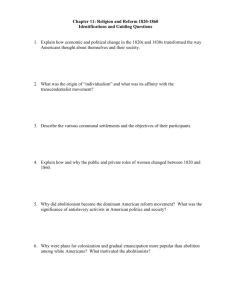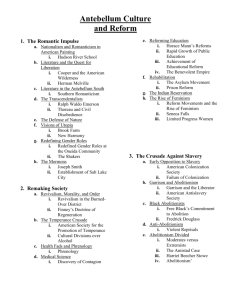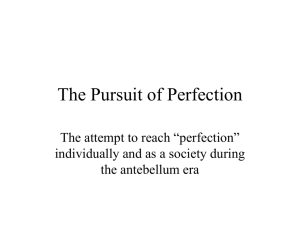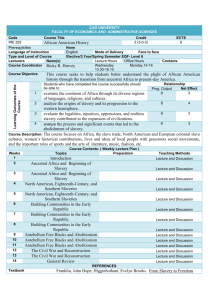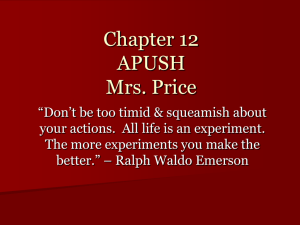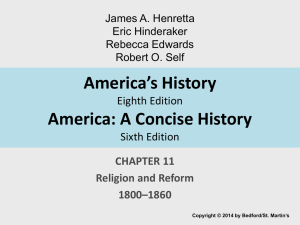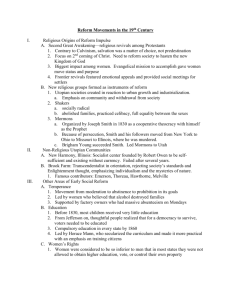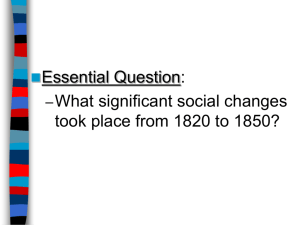Visions of American freedom Self-ownership as basis of freedom
advertisement
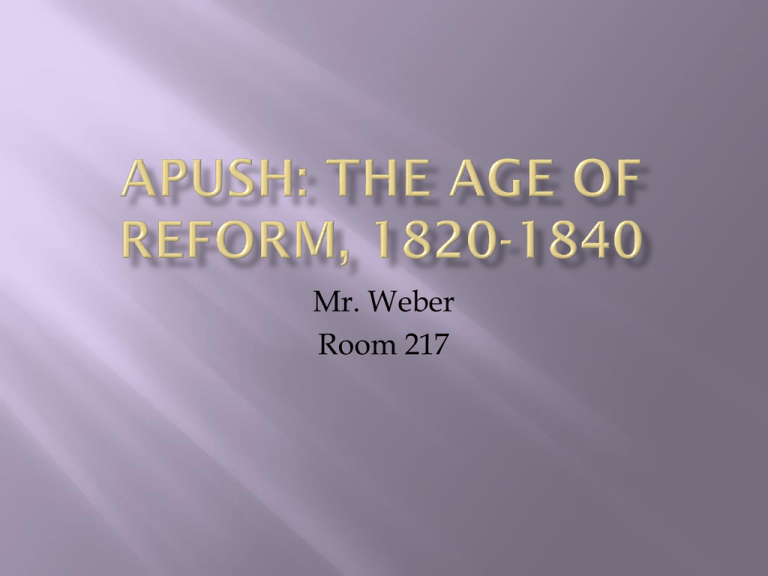
Mr. Weber Room 217 Take out your persuasive essays. What were the most important factors putting pressure on the institution of slavery before the Civil War? Volunteers to share? Activator, agenda, and objective (10 minutes) An Age of Reform lecture (30-45 minutes) Voices of Freedom Primary Source Analysis (30 minutes) John Brown and Abraham Lincoln (30 minutes) Thanks-taking reading Exit ticket and homework (10 minutes) AP Topic #10. The Crisis of the Union: Pro- and antislavery arguments and conflicts. 1. What were the major expressions of the antebellum reform impulse? 2. What were the sources and significance of abolitionism? 3. How did abolitionism challenge barriers to racial equality and free speech? 4. What were the sources and significance of the antebellum women’s rights movement? A. Overall patterns B. Voluntary associations Wide-ranging targets and objectives Activities and tactics Breadth of appeal Utopian communities Overall patterns Varieties of structures and purposes Common visions Cooperative organization of society Social harmony Narrowing of gap between rich and poor Gender equality B. Utopian communities 2. Spiritual communities Shakers Outlooks on gender and property Outcome Oneida John Humphrey Noyes Outlooks on gender and property Outcome B. Utopian communities 3. Worldly communities Brook Farm Transcendentalist origins Influence of Charles Fourier Outlooks on labor and leisure Outcome New Harmony Communitarianism of Robert Owen Forerunner at New Lanark, Scotland Outlooks on labor, education, gender, and community Outcome C. Mainstream reform movements Visions of liberation From external “servitudes” (e.g. slavery, war) From internal “servitudes” (e.g. drink, illiteracy, crime) Influence of Second Great Awakening “Perfectionism” Appeal in “burnt-over districts” Radicalization of reform causes Badge of middle-class respectability D. Opposition to reform Leading sources Workers Catholics Immigrants Points of controversy Temperance crusade Perfectionism Imposition of middle-class Protestant morality E. Ambiguities of reform Impulse for liberation, individual freedom Impulse for moral order, social control F. Program of institution building Jails Poorhouses Asylums Orphanages Common schools Thomas Mann As embodiment of reform agenda Reception and outcome American Colonization Society Founding Principles Establishment of Liberia Skepticism over Following Black response Gradual abolition Removal of freed blacks to Africa In North In South Emigration to Liberia Opposition First black national convention Insistence on equal rights, as Americans B. Take-off of militant abolitionism Distinctive spirit and themes Demand for immediate abolition Explosive denunciations of slavery As a sin As incompatible with American freedom Rejection of colonization Insistence on racial equality, rights for blacks Active role of blacks in movement Mobilization of public opinion Moral suasion B. Take-off of militant abolitionism 2. Initiatives and methods Founding of American Anti-Slavery Society (AAAS) Printed propaganda Oratory; public meetings Petitions B. Take-off of militant abolitionism 3. Pioneering figures and publications David Walker; An Appeal to the Coloured Citizens of the World William Lloyd Garrison The Liberator Thoughts on African Colonization Theodore Weld; Slavery As It Is Lydia Maria Child; An Appeal In Favor of That Class of Americans Called Africans 4. 5. Spread and growth Strongholds of support B. Take-off of militant abolitionism 6. Visions of American freedom Self-ownership as basis of freedom Priority of personal liberty over rights to property or local self-government Freedom as universal entitlement, regardless of race Right to bodily integrity 7. Identification with revolutionary heritage C. Black and white abolitionism Prominence of blacks in movement As opponents of colonization As readers and supporters of The Liberator As members and officers of AAAS As organizers and speakers As writers Racial strains within movement Persistence of prejudice among white abolitionists White dominance of leadership positions Growing black quest for independent role C. Black and white abolitionism 3. Remarkable degree of egalitarianism among white abolitionists Anti-discrimination efforts in North Spirit of interracial solidarity 4. Black abolitionists’ distinctive stands on freedom and Americanness Exceptional hostility to racism Exceptional impatience with celebrations of American liberty; “Freedom celebrations” Exceptional commitment to color-blind citizenship Exceptional insistence on economic dimension to freedom 5. Frederick Douglass’s historic Fourth of July oration D. Slavery and civil liberties Assault on abolitionism Mob violence Attack on Garrison in Boston Attack on James G. Birney in Cincinnati Fatal attack on Elijah P. Lovejoy in Alton, Illinois Suppression Removal of literature from mails “Gag rule” on petitions to House of Representatives Resulting spread of antislavery sentiment in North E. Split within AAAS Points of conflict Role of women in movement Garrisonian radicalism Relationship of abolitionism to American politics Outcome Formation of rival American and Foreign Anti- Slavery Society Founding of Liberty party Weak performance of Liberty party in 1840 election Rise of the public woman Importance of women at grassroots of abolitionism Forms of involvement in public sphere Petition drives Meetings Parades Oratory Range of reform movements involving women New awareness of women’s subordination Path-breaking efforts of Angelina and Sarah Grimké Abolitionism as seedbed for feminist movement Impassioned antislavery addresses Controversy over women lecturers Sarah Grimké’s Letters on the Equality of the Sexes C. Launching of women’s rights movement; Seneca Falls Convention Roots in abolitionism Influence of Grimké sisters Leadership of antislavery veterans Elizabeth Cady Stanton and Lucretia Mott Seneca Falls Declaration of Sentiments Echoes of Declaration of Independence Demand for suffrage Denunciation of wide-ranging inequalities D. Characteristics of feminism E. International scope Middle-class orientation Themes of feminism Self-realization Transcendentalist sensibility Margaret Fuller’s Woman in the Nineteenth Century Right to participate in market revolution Denial that home is women’s “sphere” Amelia Bloomer’s new style of dress Analogy between marriage and slavery; “slavery of sex” Laws governing wives’ economic status Law of domestic relations F. Tensions within feminist thought Belief in equality of the sexes Belief in natural differences Why did Americans have an impulse to improve American society in the first half of the 19th century? In what ways was the abolitionist movement significant to the idea of American freedom? What were the pros and cons of the colonization movement and why were many black people opposed to it? Why is this a period of institution building? How did the abolitionist movement and the women’s movement influence each other? What consequences foes Grimke believe follow from the idea of rights being founded in the individual’s “moral being?” How does Douglass turn the ideals proclaimed by white Americans into weapons against slavery? What do these documents suggest about the language and arguments employed by abolitionists? Exit ticket: What is the most interesting aspect of the reform movements we have studied? What are you finding most difficult in terms of your academic success in this class? Homework: Finish reading Ch. 12 for tomorrow’s test.
